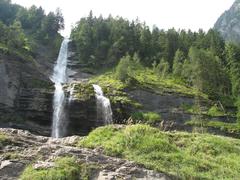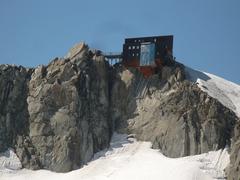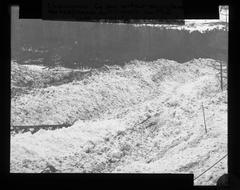
Chemin de Fer du Montenvers: Visiting Hours, Tickets, and Comprehensive Guide to Chamonix-Mont-Blanc’s Historic Railway
Date: 03/07/2025
Introduction
Set in the majestic heart of the French Alps, the Chemin de Fer du Montenvers is more than a mode of transportation—it’s a living testament to engineering prowess, alpine culture, and environmental awareness. Since opening in 1909, this rack railway has provided an accessible passage from Chamonix-Mont-Blanc to the Mer de Glace, France’s largest glacier, transforming challenging mountain ascents into unforgettable experiences for travelers of all backgrounds. The railway is both a feat of early 20th-century engineering and a key player in democratizing access to the high Alps, offering sweeping panoramas, rich history, and immersive natural encounters (Wikipedia; montenverstrain.com).
Beyond its role as a scenic journey, Montenvers is a gateway to scientific discovery and environmental education, with attractions like the annually reconstructed Ice Cave and the Glaciorium, which explains glaciology and climate change. For visitors, practical information on schedules, ticketing, accessibility, and nearby activities ensures a seamless and enriching Alpine adventure (montenverstrain.com; montenversmerdeglace.montblancnaturalresort.com).
If you’re drawn by historic trains, scientific intrigue, or the sheer beauty of the Alps, this guide will equip you with everything you need to make the most of your visit to one of Chamonix’s most celebrated landmarks.
Table of Contents
- Introduction
- History and Technological Evolution
- Visiting the Chemin de Fer du Montenvers
- The Railway as a Landmark
- Environmental Integration and Sustainability
- Cultural, Environmental, and Scientific Importance
- Visitor Information: Hours, Tickets, and Getting There
- Montenvers Rack Railway: Journey, Attractions, and Planning Guide
- Practical Visitor Information: Parking, Facilities, and Safety
- Summary and Final Visitor Tips
- References
History and Technological Evolution
Early Proposals and the Rise of Alpine Tourism
By the late 19th century, Chamonix had become a magnet for mountain enthusiasts, drawing thousands annually to the Mer de Glace. The ascent to Montenvers plateau—by foot, mule, or sedan chair—was long and arduous, sustaining a local economy of guides and porters (Wikipedia). Inspired by Swiss rack railways, Charles Durier and local investors envisioned a similar railway. After years of planning, a meter-gauge, single-track line with a rack system was approved, aiming to make the glacier accessible to all (Wikipedia).
Planning, Construction, and Inauguration
Authorized in 1903, the railway’s construction began in 1907, overcoming formidable technical challenges with tunnels, viaducts, and avalanche protection structures. The Swiss SLM Winterthur supplied the original steam locomotives. On May 29, 1909, the line opened to the public, quickly becoming a cornerstone of Chamonix tourism, with tens of thousands riding the rails each season (Wikipedia).
Modernization and Safety Innovations
The transition from steam to electric traction improved efficiency and sustainability. Modernizations in the 1960s and 1970s enhanced avalanche protection and updated infrastructure, while innovations like retractable rack sections at crossings improved operational safety. The railway’s commitment to modernization continues, with new electric rolling stock and accessibility upgrades (Wikipedia; en.chamonix.com).
Visiting the Chemin de Fer du Montenvers
Operating Hours
The Montenvers railway typically runs from late May to early November, with trains operating daily from 8:30 AM to 5:30 PM. Service frequency increases during peak summer, with trains every 20–30 minutes. Hours may vary due to weather and season, so always consult the official Montenvers Train website for up-to-date details.
Tickets and Pricing
Tickets are available online or at the Chamonix station. As of 2025, a round-trip including train, gondola, and site visits is €41.20 for adults, with discounts for children, families, groups, and people with disabilities (montenversmerdeglace.montblancnaturalresort.com). Children under 5 travel free (with proof of age), though children under 1 are not permitted for safety reasons.
Accessibility
Stations and trains are wheelchair-accessible with a companion. The Grand Hôtel du Montenvers and some exhibitions accommodate reduced-mobility visitors, but the Ice Cave requires descending over 170 steps and is not accessible to wheelchairs (Montenvers FAQ).
Travel Tips and Nearby Attractions
- Guided Tours: Enhance your visit with guided tours explaining geology, glaciology, and local heritage.
- Photo Spots: Early morning and late afternoon offer the best light and fewer crowds.
- Combine with Other Sites: Visit the Aiguille du Midi cable car or Alpine Museum for a full Chamonix experience.
- Dining: Enjoy Savoyard cuisine at Le Panoramique Mer de Glace or the historic Grand Hôtel du Montenvers.
Special Events
Look for music evenings, workshops, and themed rides during summer months. The Glaciorium hosts educational events on glaciology and climate change.
The Railway as a Landmark
The Montenvers railway is one of France’s few rack railways, ascending from 1,042 to 1,913 meters over 5.1 km in about 20 minutes (Accidentally Wes Anderson; en.chamonix.com). Its continuous modernization and annual passenger numbers—over 800,000 in recent years—demonstrate its enduring attraction and historic importance (Wikipedia).
Environmental Integration and Sustainability
The railway minimizes environmental impact by offering sustainable access to the Mer de Glace, whose retreat is a powerful indicator of climate change (Accidentally Wes Anderson). The railway encourages public transport use for access, and new electric trains further reduce emissions. The dynamic Ice Cave—excavated anew each year—highlights glacial change and human adaptation (montenverstrain.com).
Cultural, Environmental, and Scientific Importance
- Cultural Heritage: The railway opened alpine vistas to all, catalyzing Chamonix’s growth and embedding itself in the local identity (unicem.fr).
- Artistic Inspiration: The Mer de Glace has inspired writers and artists including Turner, Shelley, and Hugo, whose works helped make Chamonix world-famous (montenverstrain.com).
- Environmental Education: Montenvers is a center for interpreting and witnessing climate change, with plans for a dedicated climate interpretation center (montenverstrain.com).
- Scientific Research: The Glaciorium and ongoing field studies make Montenvers a hub for glaciology and citizen science (montenverstrain.com).
Visitor Information: Hours, Tickets, and Getting There
- Departure Station: 35 Place de la Mer de Glace, 74400 Chamonix (Montenvers FAQ).
- Parking: Biollay (free) and Planards (paid) are nearby; early arrival is recommended in summer.
- Public Transport: Easily reached by regional train and local buses; holders of the Mont Blanc MultiPass travel free on local buses (Montenvers FAQ).
- Tickets: Available online or at the station; round-trip tickets valid for 7 days after ascent.
- No Reservations: Tickets sold first-come, first-served; online tickets are non-refundable except for closures.
Montenvers Rack Railway: Journey, Attractions, and Planning Guide
The Journey
The red train climbs 871 meters over 5.1 km in 20–25 minutes, using the Strub rack system for gradients up to 22% (Wikipedia; montenverstrain.com). Trains run every 20–30 minutes in high season.
Attractions at Montenvers
- Mer de Glace: France’s largest glacier, 7 km long, visible from panoramic terraces (chamonix.net).
- Ice Cave: Accessed via gondola and about 170–430 steps, re-sculpted annually. Not accessible to those with reduced mobility.
- Glaciorium: Interactive center on glaciology, open June–September.
- Museums: Alpine Fauna Museum and Crystal Gallery showcase local wildlife and crystals.
- Dining: Le Panoramique Mer de Glace and Grand Hôtel du Montenvers offer regional cuisine.
- Overnight Stays: The Terminal Neige Refuge provides rooms and dorms for an authentic mountain night (seechamonix.com).
- Hiking: Trails to Plan de l’Aiguille, Les Bois, and Chamonix.
- Seasonal Activities: Summer features hiking and exhibits; winter sees skiers on the Vallée Blanche return by train.
Practical Tips
- Advance Booking: Recommended for trains and dining in peak season.
- Physical Demands: The Ice Cave requires fitness for many steps.
- Clothing: Layered, warm clothing and sturdy shoes are essential.
- Weather: Conditions can change rapidly; always check updates before departure.
- Accessibility: Site is generally accessible, but the glacier cave and some paths are not suitable for wheelchairs.
Practical Visitor Information: Parking, Facilities, and Safety
- Restrooms and Shops: Available at both Chamonix and Montenvers stations.
- Picnic Areas: For those bringing food.
- Souvenirs: Local products available on site.
- Safety: At nearly 2,000 meters altitude, some may experience mild symptoms; stay hydrated and pace yourself.
Summary and Final Visitor Tips
The Chemin de Fer du Montenvers is a unique blend of heritage, innovation, and environmental stewardship. From panoramic vistas and the awe-inspiring Ice Cave to hands-on science exhibits, the Montenvers experience is both educational and breathtaking (montenverstrain.com; unicem.fr). Accessibility measures, flexible tickets, and guided tours make it suitable for a wide range of visitors, while ongoing modernization efforts ensure its place as a model of sustainable mountain tourism (montenverstrain.com; montenversmerdeglace.montblancnaturalresort.com).
Plan ahead, check current schedules, and embrace the opportunity to witness the evolving wonders of the Alps. For updates, travel tips, and special offers, download the Audiala app and connect with us on social media.
References
- Chemin de Fer du Montenvers - Wikipedia
- Unicem: Chemin de Fer du Montenvers
- Montenvers Train Official Site
- Montenvers Mer de Glace FAQ
- Chamonix.net: Mer de Glace
- Accidentally Wes Anderson: Montenvers Railway













